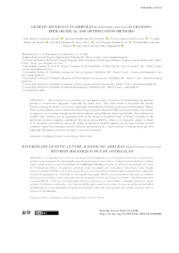Genetic diversity in Amburana (Amburana cearensis) accessions: hierarchical and optimization methods.
Genetic diversity in Amburana (Amburana cearensis) accessions: hierarchical and optimization methods.
Authorship: SOUZA, A. V. de; CARVALHO, J. R. de S.; COSTA, E. S. S.; SOUZA, C. S. de; SILVA, H. F. de J.; LUZ, J. M. Q.; MACIEL, G. M.; SIQUIEROLI, A. C. S.
Summary: The evaluation of accessions in a germplasm bank is essential for determining the potential parents in conservation programs, especially for native trees. This study aimed to determine the genetic diversity among 68 Amburana cearensis genotypes from different locations in the state of Pernambuco, Brazil. Their genetic patterns were evaluated by Inter Simple Sequence Repeat (ISSR) molecular markers and genetic divergence was evaluated through multivariate analyses using different clustering methods. The optimization method used (Tocher) was in agreement with all the hierarchical models used, in which clustering of the genotypes occurred similarly, specifically for the accession BB116, which is an important genetic material to be preserved and studied. Among the various hierarchical methods applied, the Average Linkage method exhibited higher discrimination power, allowing identification of a larger number of divergent groups, thus implying wide genetic diversity among A. cearensis accessions.
Publication year: 2021
Types of publication: Journal article
Unit: Embrapa Semi-arid Region
Observation
Some of Embrapa's publications are published as ePub files. To read them, use or download one of the following free software options to your computer or mobile device. Android: Google Play Books; IOS: iBooks; Windows and Linux: Calibre.
Access other publications
Access the Agricultural Research Database (BDPA) to consult Embrapa's full library collection and records.
Visit Embrapa Bookstore to purchase books and other publications sold by Embrapa.

